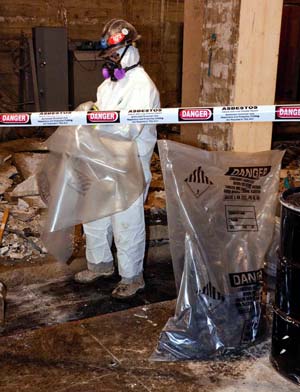The unregulated use of asbestos was once commonplace in the construction of new homes. In the 1970s, information about the danger of asbestos came to light.

Inhalation of airborne asbestos particles may cause multiple health issues including lung cancer and pleural mesothelioma, a condition that deteriorates the lining around the lungs. Approximately 75% of all malignant pleural mesothelioma cases are caused by long-term exposure to asbestos.
Asbestos Checklist
In honor of Clean Air Month (May), The following checklist will help make sure your home is asbestos free:
- Many homes constructed between 1930 and 1980 contain asbestos and require a thorough inspection. Places where asbestos may be found include insulation, HVAC systems, and ducts, floor tiles, roofing tiles, shingles, furnace flue, cement wallboard, stove range hoods, textured paint, popcorn ceilings, soundproofing material, older appliances, artificial embers in fireplaces, materials around wood-burning stoves, water pipes, and furnace door gaskets.
- If any questionable materials are found during a home inspection, they should be tested by an asbestos professional, especially before any renovation.
- Undisturbed asbestos materials are safe and do not need to be removed.
- Avoid drilling, sanding, scraping, stripping, or disturbing any asbestos materials.
- Asbestos that has been disturbed must be removed or repaired by a professional team.If done incorrectly, disturbing materials with asbestos may do more harm than good. Those who hire an asbestos professional should ask for proof of completion of federal or state-approved asbestos training.
- When the dust from maintenance work potentially contains asbestos, homeowners should not sweep the dust. Instead, a professional team should remove the hazard with protective gear. Homeowners should also take care not to track asbestos-laden dust throughout their homes.
- Whenever asbestos work is carried out in a home, the homeowners should vacate the property until the work is completed. This eliminates any risk of exposure while a professional team removes or repairs materials with asbestos.
History
It is important to note that the U.S. government began to heavily regulate asbestos in the 1970s, with a near-complete ban in 1989. In 1991, the Fifth Circuit Court of Appeals vacated and remanded the ban.
Examples of products that still use asbestos include, but are not limited to clothing, vinyl floor tile, cement shingle, cement pipe, and disk brake pads and drums.
Unfortunately, symptoms such as shortness of breath, trouble swallowing, persistent dry coughing, chest pains, and fatigue do not appear for years after exposure. The average time between exposure and diagnosis is 30 to 40 years. Those who experience these symptoms should consult a physician immediately to undergo the proper testing.
Conclusion
Please familiarize yourself with these facts about asbestos and its dangers. In the end, we want everyone’s home to be safe and asbestos free. Here is some additional information about asbestos prevention.



